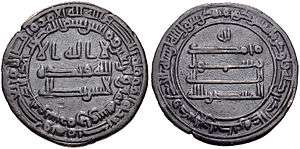Al-Muntasir
Abu Ja'far Muhammad (Arabic: أبو جعفر محمد; November 837 – 7 June 862), better known by his regnal title al-Muntasir bi-llah (المنتصر بالله, "He who triumphs in God") was the Caliph of the Abbasid Caliphate from 861 to 862, during the "Anarchy at Samarra".
| Al-Muntasir bi-llah المنتصر بالله | |
|---|---|
| Khalīfah Amir al-Mu'minin | |
 | |
| 11th Caliph of the Abbasid Caliphate | |
| Reign | 11 December 861 – 7 June 862 |
| Predecessor | al-Mutawakkil |
| Successor | al-Musta'in |
| Born | November 837 Samarra, Abbasid Caliphate |
| Died | 7 June 862 (aged 24) Abbasid Samarra, Samarra, now Saladin Governorate, Iraq |
| Burial | |
| Dynasty | Abbasid |
| Father | al-Mutawakkil |
| Mother | Hubshiya Roomiya |
| Religion | Sunni Islam |
Life
Al-Muntasir's mother was Hubshiya, a Greek slave.[1]
Muhammad ibn Jarir al-Tabari records that in A.H. 236 (850 –851) al-Muntasir led a pilgrimage. The previous year al-Mutawakkil had named his three sons as heirs and seemed to favour al-Muntasir. However, afterwards this seemed to change and al-Muntasir feared his father was going to move against him. So, he decided to strike first. Al-Mutawakkil was killed by a Turkish soldier on Wednesday 10 December 861.
On the same day as the assassination, Al-Muntasir succeeded smoothly to the throne of the Caliphate with the support of the Turkic faction. The Turkic party then prevailed on al-Muntasir to remove his brothers from the succession, fearing they would seek revenge for his involvement in the murder of their father. In their place, he was to appoint his son as heir apparent. On 27 April 862 both brothers wrote statements of abdication, although al-Mu'tazz did so after some hesitation.
Al-Muntasir was lauded because, unlike his father, he loved the house of ʻAlī (Shīʻa) and removed the ban on pilgrimage to the tombs of Hassan and Hussayn. He sent Wasif to raid the Byzantines.
Death
Al-Muntasir's reign lasted less than half a year; it ended with his death from unknown causes on Sunday, 7 June 862, at the age of 24 years (solar). There are various accounts of the illness that led to his death, including that he was bled with a poisoned lancet. Al-Tabari (p. 222-3) states that al-Muntasir is the first Abbasid whose tomb is known, that it was made public by his mother, a Greek slave-girl, and that earlier caliphs desired their tombs to be kept secret for fear of desecration. Joel L. Kraemer in his translation of al-Tabari notes on page 223:
"'Ayni comments, citing al-Sibt (b. al-Jawzi), that Tabari's statement here is surprising since the tombs of the Abbasid caliphs are in fact known, e.g., the tomb of al-Saffah is in Anbar beneath the minbar; and those of al-Mahdi in Masabadhan, Harun in Tus, al-Ma'mun in Tarsis, and al-Mu'tasim, al-Wathiq and al-Mu'tawakkil in Samarra."
See also
- Al-Muhtadi Cousin of Al-Muntasir
- Al-Mu'tazz Brother of Al-Muntasir
- Al-Mu'tamid Brother of Al-Muntasir
- Al-Muwaffaq Brother of Al-Muntasir
- Al-Mu'ayyad Brother of Al-Muntasir
References
- Kennedy 2006, p. 173.
Bibliography
- Kennedy, Hugh (2004). The Prophet and the Age of the Caliphates: The Islamic Near East from the 6th to the 11th Century (Second ed.). Harlow: Longman. ISBN 978-0-582-40525-7.
- Kennedy, Hugh (2006). When Baghdad Ruled the Muslim World: The Rise and Fall of Islam's Greatest Dynasty. Cambridge, MA: Da Capo Press. ISBN 978-0-306814808.CS1 maint: ref=harv (link)
- Kraemer, Joel L., ed. (1989). The History of al-Ṭabarī, Volume XXXIV: Incipient Decline: The Caliphates of al-Wāthiq, al-Mutawakkil and al-Muntaṣir, A.D. 841–863/A.H. 227–248. SUNY Series in Near Eastern Studies. Albany, New York: State University of New York Press. ISBN 978-0-88706-874-4.
- William Muir, The Caliphate: Its Rise, Decline, and Fall.
Al-Muntasir Born: November 837 Died: 7 June 862 | ||
| Sunni Islam titles | ||
|---|---|---|
| Preceded by Al-Mutawakkil |
Abbasid Caliph 11 December 861 – 7 June 862 |
Succeeded by Al-Musta'in |